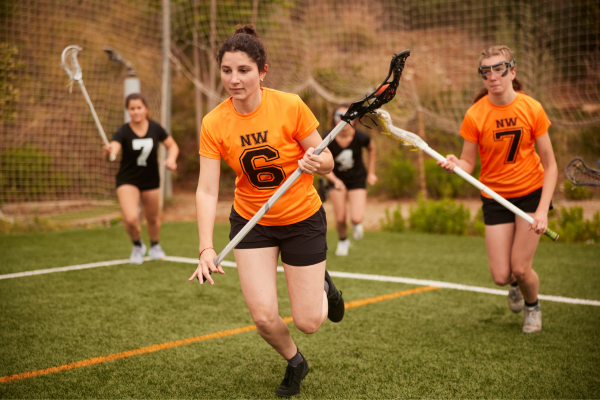Lacrosse has experienced a surge in popularity in recent years, with participation in both men's and women's collegiate levels more than doubling between 2000 and 2020.
Once considered an elite “East Coast sport” by many, lacrosse has been spreading rapidly across the American heartland over the past two decades. It is now an American staple at the youth, high school, and collegiate levels.
The increased popularity of this sport is likely due to the combined need for speed, skill, and physicality. Lacrosse takes elements from many of our favorite sports and combines them all to create a very enjoyable “product” for both participation and viewing.
While the growth of this sport is a net positive, the increase in engagement across the country has inevitably led to a rise in lacrosse-associated injuries. Although some injury patterns are shared between men’s and women's lacrosse, differences in rules and safety equipment have resulted in distinct injury profiles.
While lacrosse is a distinct sport, many within the lacrosse community consider men’s and women’s lacrosse to be different sports. This perception is largely based on the rules of engagement, which differ vastly between the two.
Men's lacrosse, characterized by greater physicality and contact, exhibits a higher overall injury rate. Conversely, women's lacrosse, involving less contact and requiring fewer pieces of safety equipment, results in higher rates of head and face injuries, particularly concussions, as well as a notable incidence of non-contact injuries.
Men vs. Women: Overall Trends and Differences Between the Sports
The divergence in injury patterns between men’s and women's lacrosse can be attributed to several factors, including variations in rules and safety equipment. Men's lacrosse is a full-contact sport that permits body and stick checking, contributing to a higher overall incidence of injuries. However, male players are equipped with hard shell helmets including a full face mask, shoulder pads, and elbow pads, providing far greater protection compared to their female counterparts.
In contrast, women's lacrosse rules prohibit body checking and minimize stick checking to the head. However, these stricter rules are accompanied by minimal protective equipment, requiring only eye protection and allowing optional headgear. Consequently, female players face a heightened risk of head and facial trauma. Notably, while injuries among men often result from direct player-to-player contact, women experience a higher prevalence of non-contact injuries and impacts from sticks or balls. These discrepancies underscore the need for a closer examination of lacrosse rules and safety equipment, particularly concerning gender-specific considerations.
Overall Epidemiology of Injury in Men’s and Women's Lacrosse

During the 2022-2023 season, men's and women's lacrosse exhibited above-average risks of injury compared to other high school sports. According to the High School Reporting Information Online (HS-RIO) database, men had a risk of 2.42 injuries per 1000 athlete exposures (AEs), while women had a risk of 2.22 per 1000 AEs. Both figures surpass the average for all sports of 2.10 per 1000 athlete exposures1.
Injuries were more commonly sustained during competition than in practice for both genders. The most frequent site of injury in both males and females was the head or face, with concussions being the most prevalent diagnosis. Following concussions, sprains and strains to the hip/thigh/upper leg and knee were the most common diagnoses in men’s lacrosse, while sprains and strains to the knee predominated in women’s lacrosse1.
The majority of injuries were managed conservatively for both men and women, with only 9.2% of injuries in men's high school lacrosse and 7.5% of injuries in women's lacrosse requiring surgical intervention1.
Head Injury and Concussion
Concussions stand out as the most common diagnosis for both men's and women's lacrosse, accounting for a significant portion of injuries. In high school men’s lacrosse, concussions make up 19.4% of injuries, while in women’s lacrosse, they represent 24.5%1. Despite the perceived "less aggressive" nature of women's lacrosse, concussion rates rival or even surpass those of men's lacrosse, a phenomenon often attributed to the absence of helmets.
Given the high burden of concussion in this demographic, there is abundant research to support the implementation of headgear in women’s lacrosse. Herman et al. demonstrated that the concussion rate for players with headgear mandates was significantly lower than for those without (0.27 per 1000 AEs vs. 0.44 per 1000 AEs, respectively)2, and also found that players without headgear had a 59% higher risk of concussion compared to individuals wearing headgear3. Baron et al. further went on to show in a prospective manner that mandating headgear use in women's lacrosse lowered not only the rate of concussions and head/facial injuries, but also the rate of injuries to other regions of the body4.
However, opposition to helmet mandates persists, primarily citing concerns such as the "gladiator effect," where increased protective equipment may inadvertently foster a more aggressive style of play. Furthermore, there are arguments rooted in the traditional ethos of women's lacrosse, which has historically emphasized finesse and precision over aggression and contact5.
While concerns and debates persist regarding helmet use, given the increasing number of female athletes sustaining head injuries, there is a pressing need to consider mandating safety-approved headgear5. The existing scientific evidence suggests that the benefits of helmet mandates likely outweigh the potential drawbacks. Therefore, organizations such as US Lacrosse should carefully weigh this evidence and consider taking a firmer stance on mandating helmets.
Lower Extremity Injuries
Lower extremity injuries are prevalent among high school lacrosse players, affecting both male and female athletes. Analysis from the HS-RIO database reveals that men and women in lacrosse commonly experience lower extremity injuries, albeit with some notable differences in injury distribution.
For male lacrosse players, knee injuries (16.1%) and injuries to the hip/thigh/upper leg region (15.1%) are most frequently reported, while ankle injuries occur less frequently (5.9%)1. Conversely, female lacrosse players face a higher risk of knee injuries (20%) and have a relatively higher incidence of ankle injuries (17.3%).

Knee injuries represent a significant concern in lacrosse, with a rate of 1.92 per 10,000 AEs6. Most knee injuries occur during competition rather than practice sessions, with anterior cruciate ligament (ACL) injuries being the most common, comprising 46.6% of knee injuries. Interestingly, the rate of ACL injury in women’s lacrosse has been shown to be greater than in any other women’s sport (Rate of 0.23 per 1000 AEs)7. Braun et al. suggest that this heightened risk may be attributed to sport-specific biomechanics, such as the reduced knee flexion angle during landing observed in lacrosse players8. Furthermore, research by Lutz et al. demonstrates a five-fold increased risk of ACL injury following concussion in lacrosse players, highlighting the interconnection between head injuries and knee injuries, and emphasizing the importance of reducing concussion rates and advocating for helmet use in the sport9. Lower extremity injuries pose significant challenges for lacrosse players, necessitating targeted injury prevention strategies and increased awareness of gender-specific injury patterns to optimize player safety in the sport.
Upper Extremity Injuries
While upper extremity injuries are generally less common than injuries to other body regions in lacrosse, they still represent a significant aspect of the injury profile, impacting both male and female players. Analysis from the HS-RIO database reveals distinct injury patterns in the upper extremities between genders.
For male high school lacrosse players, shoulder injuries account for 7.5% of injuries, followed by injuries to the arm/elbow (5.9%) and hand/wrist (5.9%) regions1. Conversely, female players exhibit a lower incidence of shoulder injuries (2.7%) and arm/elbow injuries (0.9%), but a relatively higher prevalence of hand/wrist injuries (4.5%)1. In collegiate men's lacrosse, shoulder injuries occur at a rate of 0.59 per 1000 AEs, with a higher incidence during competition compared to practice sessions (1.89 per 1000 AEs vs. 0.35 per 1000 AEs, respectively)10.
Among shoulder injuries, acromioclavicular (AC) joint injuries are the most common, followed by labral injuries and instability events10. Furthermore, men’s lacrosse players face an elevated risk of clavicle fractures compared to other athletes. The overall rate of clavicle fractures in high school athletes is reported to be 1.8 per 100,000 AEs, but lacrosse is far above average and responsible for the second-highest rate of clavicle fractures, second only to men’s hockey (5.26 and 5.27, respectively)11. Men’s lacrosse players were also shown to have a heightened risk of hand injuries compared to other sports. Only football players had a higher risk of hand injury. The most common injuries reported were fracture (45%), contusion (11.6%), and ligament sprain (9%)12.
While upper extremity injuries may be less frequent than lower extremity injuries, they still pose significant risks to lacrosse players' health and performance. Understanding the gender-specific injury patterns and implementing targeted prevention strategies are crucial for mitigating the impact of upper extremity injuries in the sport.
Lacrosse is a compelling sport, and its growing popularity in the United States provides our youth, high school, collegiate, and now professional athletes an alternative blend that incorporates many of our favorite sports into a single entity known as “Lacrosse.”
From an injury perspective, Lacrosse is attractive and relatively safe compared to other sports. However, lacrosse injuries do happen and are quite prevalent. Understanding the gender-specific injury patterns and implementing targeted prevention strategies are crucial for mitigating the impact of injuries across the sport of lacrosse including both genders. For now, it is obvious that gender-specific lacrosse rules significantly influence injury dynamics, shaping distinct injury profiles among male and female players.
Better head protection for female participants to prevent concussions and facial injuries would be an obvious advancement in the sport. ACL injury prevention protocols could also certainly positively impact non-contact ACL injuries in all comers – both male and female. To any of us who routinely watch the sport, additional protection and padding for all goalies could easily be implemented.
For the future, addressing injuries, as well as disparities, requires a multifaceted approach, encompassing rule modifications, enhanced safety equipment mandates, and continued research into injury prevention strategies tailored to each gender. By fostering collaboration between stakeholders, including players, coaches, governing bodies, and medical professionals, the lacrosse community can strive towards a safer, equal, and more inclusive sporting environment for all participants.
References
- Collins, Christy, et al. “2022-2023 National High School Sports-Related Injury Surveillance Study.” Datalys Center, 16 July 2023, datalyscenter.org/programs/rio/.
- Herman DC, Caswell SV, Kelshaw PM, Vincent HK, Lincoln AE. Association of headgear mandate and concussion injury rates in girls' high school lacrosse. British Journal of Sports Medicine. 2022 Sep;56(17):970-974. DOI: 10.1136/bjsports-2021-105031. PMID: 36002286.
- Herman, Daniel C., et al. The Effect of Headgear Use on Concussion Injury Rates in High School Lacrosse, 7 Oct. 2021, https://doi.org/10.1101/2021.10.06.21264026.
- Baron SL, Veasley SJ, Kingery MT, Nguyen MV, Alaia MJ, Cardone DA. Decreased Injury Rate Following Mandated Headgear Use in Women's Lacrosse. Bull Hosp Jt Dis (2013). 2020 Dec;78(4):260-265. PMID: 33207148.
- Acabchuk RL, Johnson BT. Helmets in women's lacrosse: what the evidence shows. Concussion. 2017 Apr 6;2(2):CNC39. doi: 10.2217/cnc-2017-0005. PMID: 30202578; PMCID: PMC6094348.
- Tadlock BA, Pierpoint LA, Covassin T, Caswell SV, Lincoln AE, Kerr ZY. Epidemiology of knee internal derangement injuries in United States high school girls' lacrosse, 2008/09-2016/17 academic years. Res Sports Med. 2019 Oct-Dec;27(4):497-508. doi: 10.1080/15438627.2018.1533471. Epub 2018 Oct 14. PMID: 30318926.
- Agel J, Rockwood T, Klossner D. Collegiate ACL Injury Rates Across 15 Sports: National Collegiate Athletic Association Injury Surveillance System Data Update (2004-2005 Through 2012-2013). Clin J Sport Med. 2016 Nov;26(6):518-523. doi: 10.1097/JSM.0000000000000290. PMID: 27315457.
- Braun HJ, Shultz R, Malone M, Leatherwood WE, Silder A, Dragoo JL. Differences in ACL biomechanical risk factors between field hockey and lacrosse female athletes. Knee Surg Sports Traumatol Arthrosc. 2015 Apr;23(4):1065-70. doi: 10.1007/s00167-014-2873-0. Epub 2014 Feb 5. PMID: 24493257.
- Lutz RH, DeMoss DJ, Roebuck EH, Mason T, Eiler BA. Sport-Specific Increased Risk of Anterior Cruciate Ligament Injury Following a Concussion in Collegiate Female Lacrosse. Curr Sports Med Rep. 2021 Oct 1;20(10):520-524. doi: 10.1249/JSR.0000000000000839. PMID: 34622816.
- Gardner EC, Chan WW, Sutton KM, Blaine TA. Shoulder Injuries in Men's Collegiate Lacrosse, 2004-2009. Am J Sports Med. 2016 Oct;44(10):2675-2681. doi: 10.1177/0363546516644246. Epub 2016 May 3. PMID: 27159306.
- McCarthy MM, Bihl JH, Frank RM, Salem HS, McCarty EC, Comstock RD. Epidemiology of Clavicle Fractures Among US High School Athletes, 2008-2009 Through 2016-2017. Orthop J Sports Med. 2019 Jul 26;7(7):2325967119861812. doi: 10.1177/2325967119861812. PMID: 31384623; PMCID: PMC6661795.
- Johnson BK, Brou L, Fields SK, Erkenbeck AN, Comstock RD. Hand and Wrist Injuries Among US High School Athletes: 2005/06-2015/16. Pediatrics. 2017 Dec;140(6):e20171255. doi: 10.1542/peds.2017-1255. PMID: 29162658.


